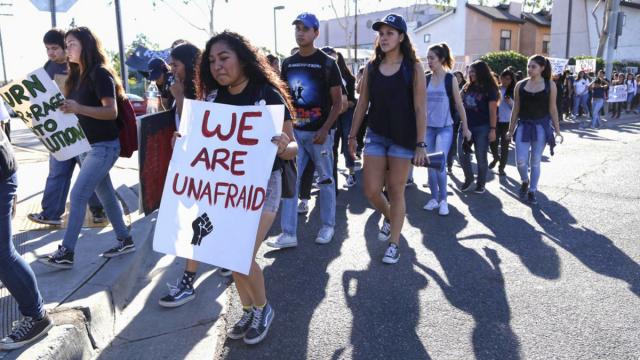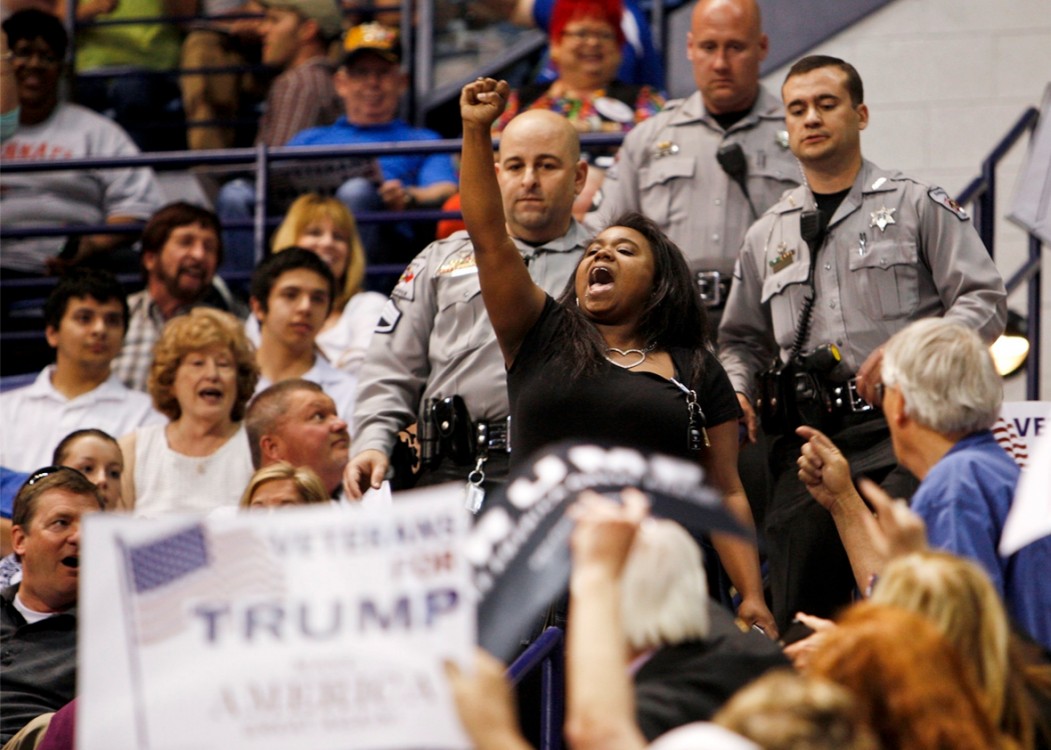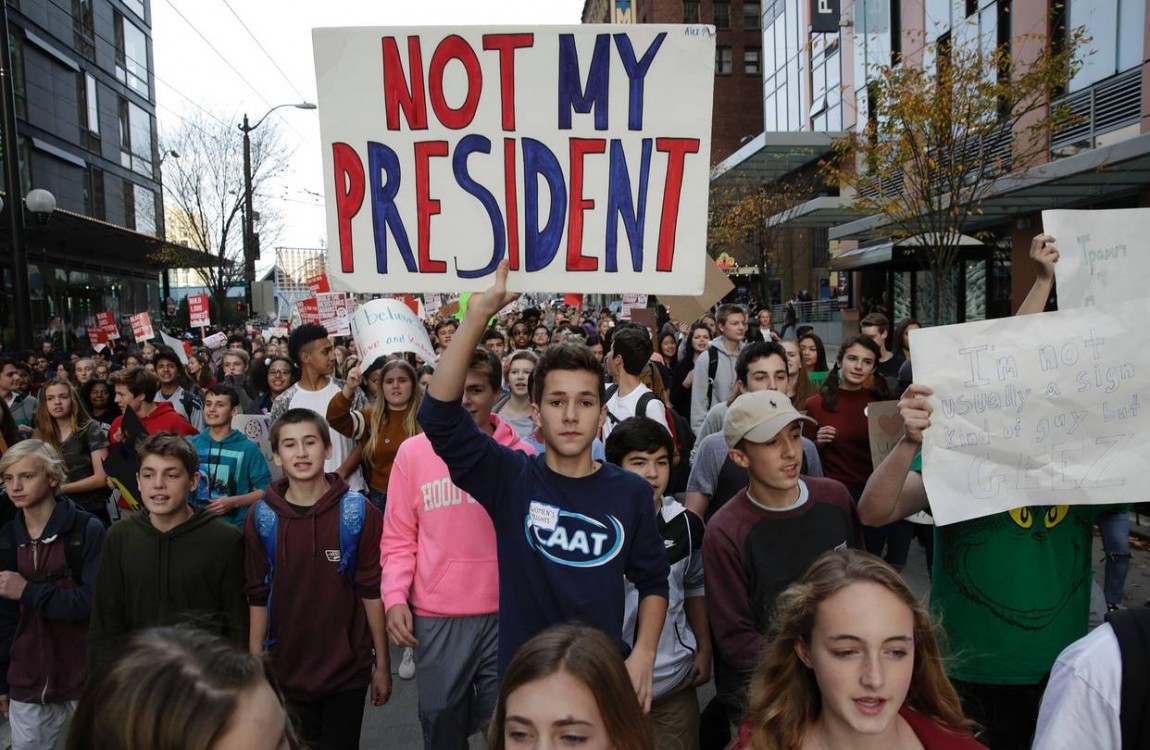
While it may be President Obama’s job to ease the country through the change in leadership to a President Donald Trump administration, the rest of the country doesn’t have to go along with it. At least, that’s the message coming from a massive show of protest and resistance in cities and towns across the nation.
An outpouring of opposition coming from students in k-12 public schools and college campuses is especially significant. Why? Public schools have long been the frontline of many of the nation’s most important societal battlegrounds.
Much of the class conflict that ignited during the Great Depression and spawned the New Deal was foretold by the challenges schools faced in educating the massive influx of poor, uneducated immigrant children into the country in the early decades of the 20th century.
In the 1950s and 60s, school desegregation was an epicenter in the Civil Rights Movement that produced landmark Supreme Court decisions such as Brown v Board of Education and Schwann v Charlotte-Mecklenberg.
Today, public schools – where non-white students outnumber their white peers and a majority live in poverty – are the nascent sign of the increasing diversity and inequality in the country. It’s no coincidence that the current Supreme Court case considering the rights of transgender individuals in public places arose from an incident in a public school.
So public schools, as long as they stay truly public, are often the first institutions to reflect society’s most important social changes. In this new era under the oncoming Trump regime, student protests are telling us something is very wrong.
What Students Are Saying
Student protests exploded as the reality of the election outcome sunk in the morning of November 9.
As The Intercept reports, that day, high school walkouts occurred across the country, with students leaving their classrooms en masse in Phoenix, Boulder, Seattle, and Des Moines, In one school in the Bay Area of Northern California, 1,500 students – half the school – took to the street to express their dissatisfaction with the election results.
“They’re angry … They’re crying and they feel unsafe,” explains the principal of that school to a local news reporter. Protests also occurred in Oakland, Contra Costa County, and San Jose.
As Education Week reports, student protests continued in many places through the rest of the week, from Omaha to Los Angeles where students in 16 schools walked out.
In Omaha, students chanted, “Not my President,” according to a local news source. “Most of us are 15, 16, 17 years old,” said one student. “We feel like we don’t have a say … By doing this, students have a voice.”
College students have joined in the protests as well with huge rallies in Austin, Texas, the University of Connecticut, and American University in Washington, D.C., according to Politico.
In Nashville, Tennessee, Vanderbilt students staged a “Protest Against Hate” and walked out of class on Friday, a local news outlet reports. “Since the election, I think people have thought that they can come out of their shells and be blatant with their racism,” one of the protestors is quoted. “It’s been hurtful to me.”
“I came out here because as a black Muslim woman I feel like my identities are being attacked,” another protestor says. “[Since] the election I’ve seen a rise in hatred.”
Student protests continued through last week.
Hundreds of students in highs schools throughout Montgomery County, Maryland left schools and formed miles long protest marches that stopped traffic and slowed commerce in various communities. “We’re trying to show that young people have a voice and we want to be heard,” one of the protestors told a local reporter. “Although we can’t get represented through voting, we can get represented through protesting,” another said.
In Silver Springs, protesting students told the local reporter, “Donald Trump doesn’t represent our views … he represents bigotry in America,” “He doesn’t respect my mother and my sister,” and “I’m Hispanic and I don’t want him to be President. I don’t like the way he speaks about women. It’s not right.”
On the West Coast, student protests continued in Seattle, Portland, the Bay Area of California, and Los Angeles. In nearly every report, the protestors relate the same messages about Trump’s election leading to a rise in hate and division in the country and to widespread fear among families, friends, and communities.
Trump Has Brought Trauma to Schools
There is little doubt that Trumps’ campaign and subsequent election have brought trauma into public education at all levels.
“The country has elected a man who threaded racist, xenophobic, and misogynistic messages and mockery of disabled people through his campaign,” Emily Bazelon writes in The New York Times. “Donald J. Trump’s victory gives others license to do the same,”
Bazelon, a Times staff writer and author of a highly regarded book on bullying explains that characteristics Trump targeted for insults and inflammatory rhetoric – being non-white, gay, or disabled – describe students who are most apt to be bullied and abused in schools. She cites numerous examples of harassment and racist displays in schools since the election.
An article for Mother Jones reports, “Bullying in schools is out of control since the election,” and cites examples of racist incidents and actions in Michigan, Pennsylvania, and Oregon.
Each of these reports points to research conducted by the Southern Poverty Law Center (SPLC) that documents over 400 allegations, so far, of election-related intimidation and harassment nationwide.
“People from all types of communities ― black, Latino, Muslim, Jewish, Asian, queer people, women ― have been physically harmed, slandered with hate speech or been the targets of racist graffiti,” explains a review of the SPLC report at Huffington Post.
“In the days following the election, students are already invoking the name of our president-elect while they spread white supremacist messages,” writes Casey Quinlan, the education reporter for ThinkProgress, the action center for the left-leaning Center for American Progress.
A wave of racist incidents has hit several college campuses as well, Politico reports, citing a specific example in which an Oklahoma student taunted black students from Pennsylvania with violent, racist messages. The fact Trump made “political correctness” a target for his ire and vowed to attack policies seeking to curb bigoted rhetoric has set campuses and college administrators on edge.
According to a report in The New York Times, Trump supporters at Texas State University distributed a flier on campus declaring, “Now that our man Trump is elected … Time to organize tar and feather vigilante squads.”
Other incidents in the article include, a Muslim woman student in San Jose State University who was grabbed by her hijab and choked, and at all-female Wellesley College, “male students from Babson College drove through campus in a pickup truck adorned with a large Trump flag, parked outside a meeting house for black students, and spat at a black female student.”
In addition to hyping up race- and gender-based harassment and abuse, Trump’s campaign rhetoric about immigrants has put many students into fear of being deported or having members of their families abducted by the state.
An article from the state-based Chalkbeat news service reports, “In the wake of a campaign in which Trump talked about ramping up deportations, building walls, and banning Muslims from entering the country, teachers at schools that serve immigrants and their families faced intensely personal questions. Will I be forced to leave? Will my parents?”
Another fear among student and civil rights advocates is that efforts to discontinue harsh “zero tolerance” behavior policies in schools and to end a “school to prison pipeline” that pushes students into the criminal justice system will be curtailed under a government regime that emphasizes “law and order,” as Trump has vowed to do.
How Educators are Responding
A recent report by PBS News Hour describes some of the steps educators are taking to deal with “the Trump effect” in their schools.
The reporter Kavitha Cardoza notes teachers “are not surprised at all that some of these emotions are spilling into the classroom” because schools are often “microcosms” of society and children tend to absorb whatever is stressing their parents.
“I think it must be so terrifying to be a kid,” a teacher tells The Hechinger Report. “To feel like you have no power and these ‘other’ adult strangers are making decisions that could rip away family members. Kids know what racism is and are struggling to understand why and how people in this country could make a leader out of an open racist.”
In numerous interviews, teachers explain steps they are taking to deal with the stress and heightened tension in their classrooms, including teaching students about respect for others and the value of community. Teachers are making a concerted effort to provide students with a calm oasis and to help students with their emotions.
This kind of extra-curricular support is especially important in programs serving high populations of students who don’t speak English as their first language. As a recent report for the Education Writers Association explains, “Many school districts have begun offering additional counseling and support services for students who fear for their futures under the next presidential administration.”
College campuses are taking steps as well. According to the campus newspaper at the University of North Carolina, faculty are going outside their usual curriculums to deal with traumatized college students. “I had half a dozen students crying in class,” one professor explains. “I had never in my life seen something like this.”
“We are going to find a way to support these students,” another professor says. “We will stand with them. We’ll make sure that they are safe.”
A teacher-blogger at Education Week explains why teachers are being thrust into the forefront of addressing the social stress that Trump is fomenting in society. “I don’t strongly support particular candidates in my classroom. That doesn’t feel like my place,” she writes. “Teaching, though, is inherently political. We ask our students to think critically, to question existing systems, to imagine what might be better. We push for them to consider who has power, why, and how we can change those existing and often oppressing structures.”
Further, research shows that learning is stunted when the most basic need to feel safe and respected is not met. Teachers simply can’t do their jobs without addressing the underlying stress and emotions of their students.
We Should Listen to Them
None of this is to say that the Trump administration isn’t legitimate.
He did win the presidency, despite not winning the popular vote. He has told his supporters who are spreading hatred to “stop it.” And his former campaign manager and current advisor has called on President Obama to speak out against the protests.
But student protests are legitimate too. They’re telling us it’s time for bold stands, not wait-and-see equivocations in the face of rising hatred and discrimination in the nation. We should listen to them.
3 WAYS TO SHOW YOUR SUPPORT
- Log in to post comments
















Comments
DH Fabian replied on
Reality check
We're 20 years into our war on the poor, and even liberals have ignored the consequences. The majority of US poor are white. The only time liberal media have acknowledged white poverty was to depict them as contemptible, low-wage, right wing ignoramuses.
The US shut down/shipped out a huge number of jobs since the 1980s, ended actual welfare in the 1990s. Not everyone can work, and there aren't jobs for all. The last I heard, there are 7 jobs for every 10 jobless people who still have the means to pursue one (home address, phone, etc.). While that's an improvement, what do you think happens to those who are left out?
The fact is that we are more divided by class and race than we were eight years ago.